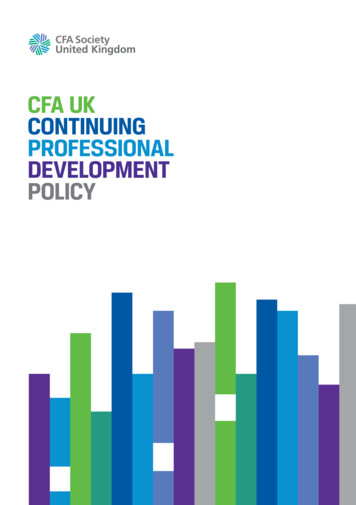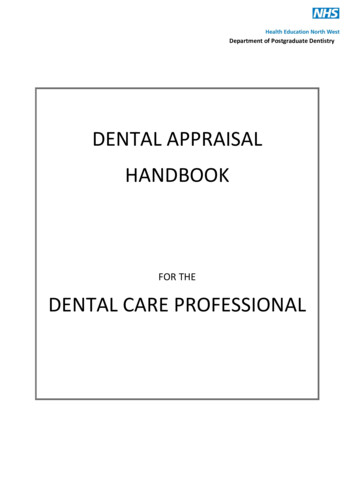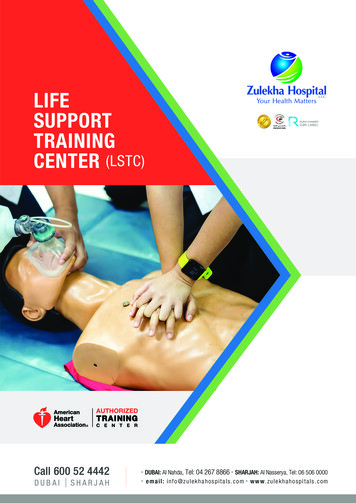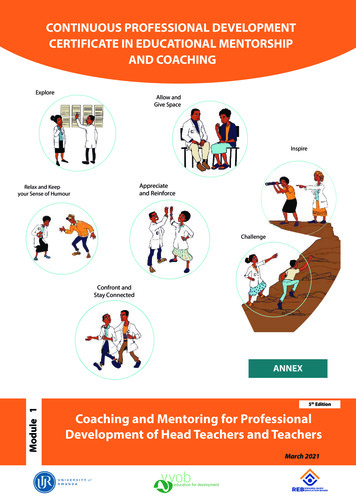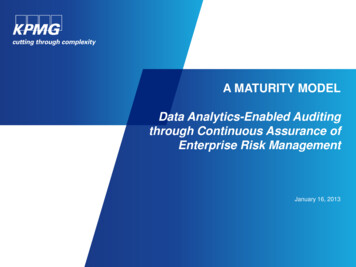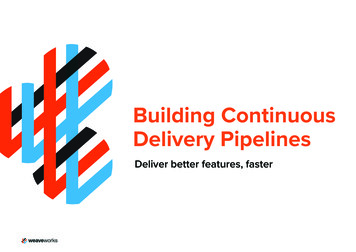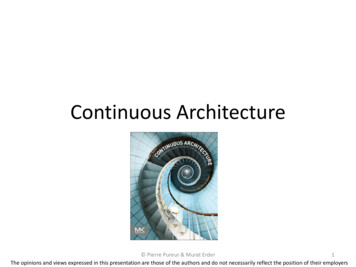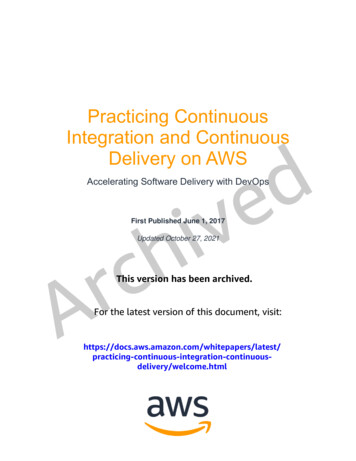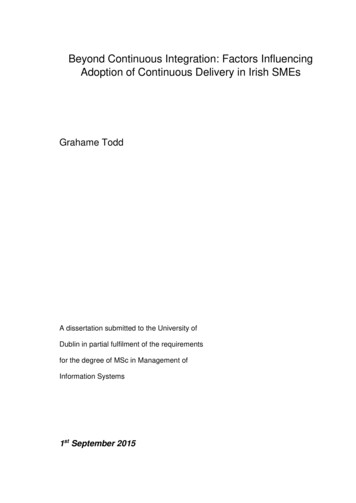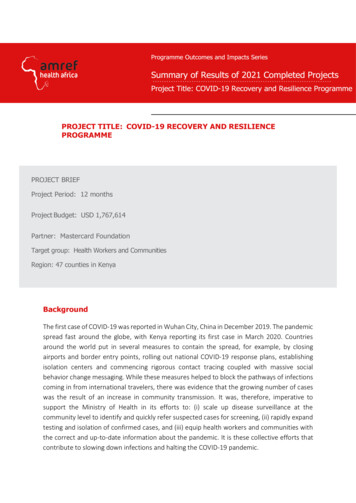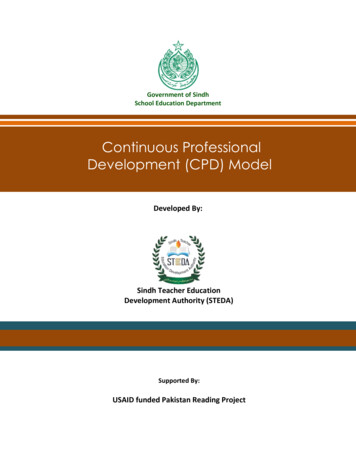
Transcription
Government of SindhSchool Education DepartmentContinuous ProfessionalDevelopment (CPD) ModelDeveloped By:Sindh Teacher EducationDevelopment Authority (STEDA)Supported By:USAID funded Pakistan Reading Project
ContentsACKNOWLEDGEMENT .31.INTRODUCTION OF THE CPD MODEL .42.CPD MODEL DEVELOPMENT PROCESS.52.1.3.THE CPD MODEL FOR ELEMENTARY SCHOOL TEACHERS IN SINDH .63.1.3.2.3.3.3.4.3.5.4.CPD STRATEGIC PLANNING: KEY PROCESSES . 5PREAMBLE . 6ARRANGEMENTS FOR COMPULSORY EDUCATION AND PROFESSIONAL DEVELOPMENT . 6ARRANGEMENTS FOR MANDATORY EDUCATION AND TRAINING . 7ARRANGEMENTS FOR OTHER TRAININGS . 7PREMISES OF THE MODEL . 8THE CPD MODEL .94.1.4.2.4.2.14.3.4.4.4.5.FLOW OF THE CPD ACTIVITIES UNDER THE MODEL . 10CLUSTER MAPPING UNDER THE MODEL . 11MULTI-GRADE TEACHING . 11IMPLEMENTATION PROCESS OF THE CPD MODEL . 12ROLE OF INDIVIDUAL / INSTITUTIONS INVOLVED IN THE IMPLEMENTATION OF CPD . 13KEY PERSONNEL INVOLVED IN THE CPD PROGRAM, THEIR SELECTION AND ROLES AND RESPONSIBILITIES . 165.LIST OF ABBREVIATIONS AND ACRONYMS . 186.FUNCTIONAL DEFINITION OF TECHNICAL TERMS . 21Page 2 of 23
AcknowledgementCPD Model was developed through the invaluable participation of several Sindh government entities,including the Sindh Teacher Education Development Authority (STEDA), Provincial Institute of TeacherEducation (PITE), Bureau of Curriculum and Extension Wing (BoC-EW) and faculty of GovernmentElementary Colleges of Education. In addition, the USAID Pakistan Reading Project provided technicalsupport.Certain individuals substantially contributed in the development of this document, including Mr AbdulMajeed Bhurt, Executive Director STEDA; Mr. Haroon Leghari, Director STEDA; Mr Qamar ShahidSiddiqui, DG PITE Sindh; Mr Mushtaque Ahmed Shahani, Director BoC and Mr Asghar Memon, AdditionalDirector (TTIs) BoC.Pivotal roles were also played by Mr Anjum Parvez, Head of Office Sindh USAID Pakistan ReadingProject; Mr Aamir Latif Siddiqui, Policy and System Coordinator Sindh USAID Pakistan Reading Project;Ms Maria Soomro, Policy and System Officer USAID Pakistan Reading Project. Lastly, contribution of DrKhalid Mehmood, Consultant for the USAID Pakistan Reading Project was highly valuable.School Education DepartmentGovernment of Sindh, KarachiPage 3 of 23
1. Introduction of the CPD ModelThis CPD model based on cluster-cum-school based approach. The professional development activitiesunder the framework will be managed through a central elementary/ high school (referred as ClusterHub School in the framework). The method of formation of clusters and selection of Cluster Hub Schoolshas been adopted from the ‘School Clustering Policy 2016’ and School Consolidation Policy (2012). Thenumber of schools in a cluster will be 10 to 12, located within a radius of 15 kilometer from the ClusterHub School/Campus School. The CPD will be delivered through blended mode: Face-to-face interaction of trainers (who are referred as Guide Teachers/Subject Coordinators inthe framework) with teachers in workshop setting; (a) for all teachers within the school and/orat cluster level on regular basis for a short duration (two-hours to one day), and (b) for lowperforming teachers within Taulka/District for one week to four-weeks during vacations.On the job support through mentoring visits of schools by the trainers.Online support for teacher and trainers through a dynamic web-portal to be administered by adedicated team of professionals based at PITE.Key characteristics: The model represents a structure and approach to professional development ofteachers that is different from that of other forms of professional development. It ensures peercoaching of teachers. The trainers (referred as Subject Coordinators in the framework) will be teachersof the same school or nearby school, who will support their peers in implementing the learnt knowledgeand skills through professional development activities. The model combines the benefits of face-to-facemeetings in the local setting, and self and peer study in between meetings where teachers apply whatthey learn, and reflect on the results. Moreover, the trainers will formally conduct fortnightly session ofteachers of 2-3 schools assigned to her/him to discuss content and pedagogical issues faced by theteacher in the schools. The other trainers (referred as Guide Teachers in the framework) will also havementoring visits of the schools within the cluster. They will also have quarterly a day-long conference atTEIs to discuss important problems and issues occurred and their solutions proposed during the quarter.Contrasted with “training” that is characterized by an expert trainer who delivers content, the modelfunctions democratically, with participants working collaboratively, sharing their expertise, reflecting onpractices, and respecting each other’s knowledge, experience and practices. Therefore, the modelensures that the development process is collaborative, with teachers of similar skill and confidencesupporting, observing and coaching each other.Focus: All primary and elementary school teachers will attend the professional development activitiesevery year. Along with building capacity of teachers on reading skills, the teachers will get chance toimprove their professional competence in other aspects of the languages (English and Sindh/Urdu) andalso in other subjects including Science and Mathematics.Management: At provincial level, PITE will take lead in managing all the CPD activities in the field as perthe Sindh School Education Standards and Curriculum ACT 2014. At cluster level these activities will bemanaged by the Cluster Hub School/Campus School within a cluster (as per the School Clustering Policy2016), and with the support of DEO, TEO and TEIs at district level. Primarily PITE, with support of BCEWand private organizations (to be identified by the School Education Department in consultation withSTEDA and RSU), will be responsible for developing all type of training material. The content for theprofessional development activities will be derived from the training needs analysis. The focus of thematerial will be on Pedagogical Content Knowledge (PCK).Page 4 of 23
2. CPD Model Development ProcessThe processes and efforts for developing the CPD model were guided by a comprehensive andrigorously constructed conceptual framework informed by: a) the National Professional Standards forTeachers in Pakistan (2009); b) The Sindh School Education Standards and Curriculum Act, 2014; c)Sindh Education Sector Plan (SESP) 2014-18; and d) the Policy on ‘School Clustering in Sindh, 2016.2.1.CPD Strategic Planning: Key ProcessesDevelopment of CPD model process started by developing a consensus within School EducationDepartment regarding how the strategic planning process would be carried out, as well as what thescope, timelines, key deliverables and guiding principles would be. The Figure 2.2 summarises theprocess.1. Policy and literature review Sindh School Clustering Policy (2016) Sindh CPD Frameworks (2016, 2014) Sindh CPD Accreditation Framework(2016) The Sindh School Education Standardsand Curriculum Act (2014) Sindh Teacher Education Strategy 2018addressing the Issue of Quality (2012) School Consolidation Policy (2012) Sindh TED Policy (2009) CPD practices in other provinces ofPakistan Regional and international literature andpractices2. Explore current CPD interventions in Sindh Individual and group meetings withDepartmental Heads and staff of wings ofSED GoS, along with projects working inEducation Sector in Sindh FGDs with key stakeholder Institutional analysis of PITE, and selectedGECE, and DETRC Consultative meetings and workshop3. Draft CPD model4. Review Workshop5. Consultation and wider dissemination with field managers of school Education at regionallevels6. Finalized CPD model7. Approval and notification at department levelPage 5 of 23
3. The CPD Model for Elementary School Teachers in Sindh3.1.PreambleNature of CPD programmes depends upon the requirements of a system by an individualworking for the system. For elementary school teachers including literacy & Non Formal basicEducation teachers providing their services to School Education Department, Government ofSindh (GoS), broadly three categories of professional development are envisaged:A. Compulsory education and training- the CPD Professional development to meet National Professional Standards for Teachers(NPST) and School Curriculum Standards Recurring issues in education like multigrade teaching in schools with single, two oreven three teacher Emerging issues in education/community to prepare staff for addressing these issuethrough various means including student counselling and parental educationB. Mandatory education and training Induction trainings to familiarize with School Education Department, understand roleand responsible, and get ready to perform these roles as quickly as possible Promotion linked trainings to ensure that the staff has sufficient understanding of thenew role and able to perform it efficientlyC. Academic and/or professional progression Career progression linked professional, like formal degree/certificate programmes, toencourage existing staff for enhancing their qualification3.2.Arrangements for Compulsory Education and Professional DevelopmentThe CPD model agreed by the stakeholders, is for professional development of the primary andelementary school teachers to meet NPST and School Curriculum Standards. In the followinglines, goals and target audience, bases and mean to measuring impact of the CPD, are described.Goal and target Audience: The model has been evolved for CPD of primary and elementaryschool teachers including: ECT, SECT, PST, JST, JEST, EST, SEST; and HST, SST and SSST (if she/heis teaching in primary and/or elementary schools) and those working as facilitators/teachers inNFBE and literacy centres. The ultimate goal of the CPD is to improve quality of education in theprovince as per vision of the School Education Department, Gos and to meet National/ProvincialProfessional Standards for Teacher.Bases of the CPD model: The model encompasses the provisions made in various policyguidelines on the CPD issued by the School Education Department from time to time. The modelhas mostly used terminology of these guidelines. One of the policy guidelines talks about thecreating school clusters to managing delivery of education and ensuring quality of services(School Clustering Policy 2016); and another one, School Consolidation Policy 2012 Talks aboutthe Campus schools. The School Clustering Policy 2016 also provides timelines for this task. If ittakes more than expected timeframe given in the clustering policy (2016) to create SchoolPage 6 of 23
Clusters and identify Cluster Hub School/ Campus Schools1 (CHS/CS) to make them functional,School Education Department may constitute clusters for CPD only, in order to roll-out the CPDactivities proposed in the model.Measuring the impact of the CPD activities under the model: The model envisages professionaldevelopment of teachers as a regular feature of School Education Department. It is mandatoryfor every teacher including literacy & non formal basic education teacher where it is possible totake part into it. The impact of the CPD will be measured through the students’ achievement onannual basis. Special trainings for those teachers will be organized during the summer vacationswhose students consistently performing lower than the expected level.3.3.Arrangements for Mandatory Education and TrainingFor Induction TrainingFor all newly recruited teachers, induction training will be organized, immediately after theselection of the teachers. The training will include face-to-face component for at least twoweeks followed by a mentoring support in the school for one month through the proposedmodel. At the end, the trainee will come back to the institution from where she/he hasattended the two weeks training in the beginning, for sharing her/his experiences and her/hisperformance evaluation. All the trainees will be evaluated before their regular appointment inthe system.For Promotion Linked TrainingThose teachers whose promotion is due in near future, will undergo a promotion linked training.Generally, the trainings will be organized in summer vacation. The duration and otherrequirements of the training will be determined by the School Education Department, keeping inview the nature of the position for which the trainees will be aspired for. The process could beadopted for the time scale progression.3.4.Arrangements for other TrainingsFor Career ProgressTeachers’ will be encouraged to improve their qualification, a) to meet the minimumrequirements of the system, and b) to get higher positions in the system. For this, the teacherwill have to undergo accredited programmes offered though modular approach by the SchoolEducation Department in collaboration with a degree awarding institution2 and/or attendingprogramme at a degree awarding institution.12AS per School Consolidation Policy 2012Accredited by STEDAPage 7 of 23
3.5.Premises of the ModelThe proposed CPD model is: based on identified teacher needs to address school curriculum objectives andsupport School Education Department in achieving its vision and following itsmission used for improving students’ achievement providing access to all teachers for their professional development at their schoollevel delivered through participatory approaches an ongoing process and requires an inbuilt mechanism to ensure support ofteachers in classroom cost effective, as it reduces the travelling of the teachers for their professionaldevelopment, to a large extent sustainable by making it part of administrative and staff’s appraisal systemPage 8 of 23
4. The CPD ModelThe figure depicts the overall process of the CPD model for SindhIdentify StudentLearning Needs(1)Identify TeachersNeedsCPD tify CPDTargetsOn-going Support(5)(3)Design andImplement CPD(4)Explanatory NotesStep 1.To begin with, student learning needs will be identified by using reports of large scale assessment (e.g.PEACe and SAT reports) based on provincial/national curriculum standards for all classes, and afterwardsdata to be gathered from CPD programmatic activities (e.g.: quarterly student assessment, students worksamples, and Subject Coordinator observations)Step 2.Teacher professional development needs (to address student learning needs) will be identifying by usingNational Professional Standards for Teachers in Pakistan (NPSTP) and studies conducted with particularreference to elementary school teachers performance in Sindh, and classroom assessment and CPDprogrammatic activitiesStep 3.CPD interventions will be identified that will be aligned with targeted areas emerged from data gatheredunder steps 1 and 2.Step 4.After development of CPD activities/materials, it will be got accredited from STEDA beforeimplementation.Step 5.DETRCs, REECs, TRCs, In-service TEIs (and where necessary GCEs and GECEs also), DEOs will be engagedfor training, mentoring and monitoring at Taluka, Cluster and School levelsStep 6.Evaluation of the CPD programmes will be carried out by the implementing institution/agency, and alsocould be done by other institutions including public and private organizations and authoritiesPage 9 of 23
4.1.Flow of the CPD Activities under the ModelThe Guide Teachers3 will attend a training programme at Taluka/district level,keeping in view the number of Guide Teachers in the surrounding. For this purpose,the venue will be CHS/CS situated at Taluka headquarter and/or for district level TEI(if exits) otherwise CHS/CS situated at district headquarterii.Initially all teachers will attend a week-long training delivered by the Guide Teachersat cluster level, afterwards selected teachers will work as subject coordinators4 forproviding mentoring support to other the teacher of nearby 2-3 schools.iii.During a month, the Guide Teacher5 will visit at least 2-3 schools within her/hiscluster to have direct observation of the teaching learning activities in the schools.iv.Each Subject Coordinator will document the mentoring session highlights includingclearly defined problem and its solution (if it has found)v.In a month each Guide Teacher will hold at least one meeting with the teachers andsubject coordinators to discuss problem(s), they have come across with, to find outits solution. The problem may be in content area and/or pedagogy of the subject.vi.On the last day of alternate month, Guide Teachers of the same Taluka/District willmeet with a designated TEI faculty of the district, in case there is no TEI within thedistrict, they meet with designated TEI faculty of neighbouring district.o The faculty will share at least one of the recent developments in the teaching of thesubjects.o The faculty will discuss the solution of the problem with Guide Teachers, and shareits solution, if she/he could.o In either case, the faculty will post the problem and its solution (if she/he had) onthe discussion board of the SEEN6 for its wider dissemination and benefit, andseeking alternate solution(s) of the problem.vii.All the Guide Teachers of a district will have quarterly7 a day-long conference at aTEI to discuss important problems and issues occurred during the quarter. In thismeeting sample work of students including answer sheets of the students’ quarterlyassessments will also be analysed to monitor the student progress and to identifymisconception(s) if any.viii.All these activities will jointly be supervised by the DEO (Primary) and/or DEO(Elementary, Secondary and Higher Secondary)8 and the head of TEI in the district,and approved by the concerned Director School Education.i.3Complete a certified training to be determined by PITE in consultation with STEDATwo subject coordinators: one for mathematics and Science, and other for English and Sindhi/Urdu. Thesecoordinators will be teachers of the schools for which they will act as subject coordinator5The travelling and other expenses incurred by Guide Teachers for CPD activities, will be facilitated throughregular budgetary provision to be available for the CHS/CS6Sindh Elementary Education Network (a proposed web-portal for CPD)7There will be 3 conferences each year.8Keeping in view administrative control of CHS/CS4Page 10 of 23
4.2.Cluster Mapping under the ModelAs per School Clustering Policy (2016) and/or School Consolidation Policy (2012), the ClusterHub School (CHS)/Campus School (CS) will be centre of CDP activities in the cluster. The schoolshould have adequate facilities and ideally be situated in or closer to a town centre where othersocial and commercial services are available. Under the policy provisions, following are keyconsiderations for selection of the CHS/CS:a. relatively good potential accessCentrally located and be accessible for other schools in the cluster through publictransport or walking distanceb. comparatively high enrolment and students’ retentionc. better resourced in terms of teachersWell-resourced in terms of number of teachers (more than 5 in case of a primary ormiddle school, more than 8 in case of an elementary school, and more than 10 in case of asecondary school — sufficient number of subject teachers should also be available)d. well-equipped and better resourced in terms of physical facilitiesSufficient number of rooms are able to allocate at least one room for cluster activities; andfacilities such as a boundary wall, drinking water, electricity, toilet, furniture for teachersand students. Any residual need for improving facilities can be taken up with relevantauthorities.e. One level higherAt least a middle or secondary in case of all primary schools in the cluster. In other cases,one level higher than the other school in the cluster. If there is no middle/elementary orsecondary school in the cluster, then the main primary school will be upgraded toelementary level following due process.There will be multiple types of school clusters categorized as follows:i. School cluster with all primary schools: Primary Cluster;ii. School cluster with one middle or elementary school: Elementary Cluster;iii. School cluster with one secondary school: Secondary Cluster;iv. School cluster with Campus School as the Guide School: Campus School Cluster.4.2.1Multi-Grade Teaching:Most pre-service and in-service teacher training systems prepare teachers to teach inmonograde schools with a perception that teachers teaching in multi-grade contexts will adaptthe learning and adjust their teaching accordingly.In order to address the issues related to multi-grade teaching, STEDA with the support of PITE,BoC and European Union have piloted this model for multi-grade school teachers (developedfour manuals by PITE & certified by STEDA) in the newly formed 13 clusters under the 2016notified School Clustering Policy of the Government, in District Shaheed Benazirabad.Page 11 of 23
4.3.Implementation Process of the CPD ModelSchool Education DepartmentSTEDA Accredit CPDproviders/programmes/activities Yearly/ need basedreview meeting withBCEW, PITE andDirectors SchoolEducationBCEW (DCAR)Technical Assistance todevelop and reviewmodules, manuals,learning materialsCurriculumWing andAcademic &Training Wing Coordination withthe concerneddepartments/institutionsDirectors School EducationPITE Take lead inimplementation ofCPD activities Yearly planningmeeting of PITE withDEOs/DirectorsSchool EduTEIs(DETRCs, REECs, TRCs GCEs, GECEs)Approve Guide Teachers’ appointment in consultation with PITEDistrict Education Officer (Primary) /(Elementary, Secondary & Higher Secondary) Six monthly planning and review meeting of DirectorSchools Primary and PITE Quarterly planning and coordination meeting of TEOs andCHS/CS heads with DistrictTaluka Education Officer PrimaryTaluka Based Select Guide Teachers from the existing pool of Master Trainers and appoint them GuideTeachers in the CHSs/CS after approval from Director Education. Training of Guide Teachers by TEIs under the guidance of PITE Yearly planning and orientation meeting of Guide Teacher and CHS/CS heads. Quarterly review and coordination meeting of CHS/CS heads with TEOs Quarterly review meeting of Guide Teachers.Cluster Hub School/ Campus School (Cluster Based ) Selection and training of Subject Coordinators by head of CHS/CSMonthly planning and review meeting of Guide Teachers with Subject Coordinators.Long term trainings of schools’ teachers during summer and winter vacationsMonthly meeting of school teachers on the last day of the month with Guide TeachersEnsue availability of training resources for the implementation of CPD activities at schoolsSchool Based Nomination of two Subject Coordinators (one for mathematics and science, and other for English and Sindhi/Urdu) for 2-3 schools (to be identified by GuideTeachers within the 2-3 schools) by CHS/CS head Fortnightly meeting (after school timings for 2 to 3 hours) of the 2-3 schools’ teachers and Subject Coordinators Monthly at least one visit of the subject coordinators to every school (2-3 school) assigned to her/himfor 12mentoringPageof 23 and academic supervision of the teachers Mentoring and academic supervision of teachers by Guide Teachers through un-announced visits
4.4.Role of Individual / Institutions Involved in the Implementation of CPDThe following section gives further clarity of roles and responsibilities of the institutions to beengaged in the implementation of CPD.4.4.1. Provincial Institute of Teacher Education (PITE) 9Identify training needs of teachers with the help of BCEW (PEAC) and STEDA, anddata available from SAT and regular student assessment under CPD and/orDepartment al/school assessments, and Guide Teachers’ observations.Invite yearly planning meeting with the Directors School Education and DEO(Primary) / (Elementary, Secondary and Higher Secondary) at PITE.Develop annual training calendar.Develop training and learning materials in collaboration with BCEW.Coordinate with BCEW for the student assessment, support to curriculum andtextbooks development.Coordinate with STEDA for accreditation programmes and materials.Train Guide Teachers and develop capacity of CHS/CS Heads, TEOs and DEO(Primary) / (Elementary, Secondary and Higher Secondary) to support and monitorthe CPD activities.Coordinate quarterly planning and coordination meeting with the DEO (Primary) /(Elementary, Secondary and Higher Secondary) at the District level.Coordinate with DEO (Primary) / (Elementary, Secondary and Higher Secondary) formanaging the CPD.Maintain the database of Guide Teachers, Subject Coordinators, and Teachers (PITEcan also use the HRMIS being developed by the School Education Department andTEMIS to be developed by STEDA).Develop and maintain Sindh Elementary Education Network (SEEN) Portal forhosting online programmes and support9, also linking it ILMI messaging service10.Engage faculty of education of universities to conduct studies on CPD programmesincluding evaluation of CPD programmes.Organize annual conference of Guide Teachers.Organize national conference after every two years on CPD in collaboration withSTEDA.Place problems/ solutions of Sindh Elementary Education Network (SEEN).10An SMS complaint and help service called “Ilmi” for everyone connected with education - be it students, teachers,headmasters, parents or taluka or district officersPage 13 of 23
4.4.2. Sindh Teacher Education and Development Authority (STEDA) Ensure quality by accrediting and approving CPD programmes designed by PITE and / orby agency institution (public or private) engaged by PITE or the School EducationDepartment.Contribute in identifying teachers’ professional needsDevelop selection criteria for selecting Guide TeachersDevelop and implement rules of business to link CPD activities with teacher licensingEvolve and implement mechanism to ensure quality of CPD programme implementationConduct research on teacher professional developmentDevelop and maintain TEMISOrganize international conference after every five years on CPD4.4.3. Bureau of curriculum and Extension Wing (BCEW) Sindh/ Directorate of Curriculum,Assessment and Research (DCAR) Assess students’ achievements and conduct diagnostic assessments of teachers inPedagogical Content Knowledge (PCK)Support PITE in developing teacher training material to address their identified needsConduct research on teacher professional developmentCollaborate with PITE in curriculum and textbook development and evaluation to keepthem abreast with latest development in the curriculum and bring contextualknowledge of classroom practices in textbook development and evaluationContribute in developing Guide Teachers’ trainings material4.4.4. Reform Support Unit (RSU) of School Education Department (SED) Arrange resources to strengthen SED wings for adopting and implement the CPD model.Monitor the implementation of the CPD and assess its impact with help of technicalassistance from development partners and/ donors by engaging private sector.Coordinate among the key institutions (like STEDA, PITE, BCEW) involved in theimplementation of the CPD programme.4.4.5. Director School Education Primary/ Secondary Liaison with PITE in developing plan for CDP activities and support in implementation ofthe developed activitiesAppoint Guide Teachers.Monitor and supervise CPD activities in their respective division.4.4.6. District Education Officer (DEO) Primary/ Elementary, Secondary and HigherSecondary In consultation with PITE/TEIs, plan and coordinate CPD activities in the district.Approve cluster CPD activities plan.Page 14 of 23
Provide support for CPD activities at Taluka/Cluster level.Monitor and review performance of clusters.4.4.7. Taluka Education Officer (TEO) Under the guidance of PITE, respective TEI and DEO (Primary) / (Elementary, Secondaryand Higher Secondary), and in close consultation with CHS/CS heads, ensureimplementation of CPD activities of the clusters in her/his Taluka.Recommend Guide Teachers for CHS/CSProvide support for cluster level CPD activities.Monitor and review performance of clusters in delivering CPD programme.4.4.8. CHS / CS Head Nominate Guide TeachersLead teachers’ professional development at cluster level.Facilitate implementation of the
The ultimate goal of the CPD is to improve quality of education in the province as per vision of the School Education Department, Gos and to meet National/Provincial . The School Clustering Policy 2016 also provides timelines for this task. If it takes more than expected timeframe given in the clustering policy (2016) to create School .
